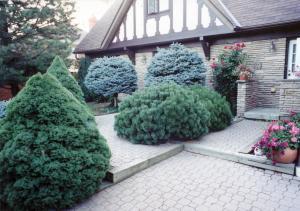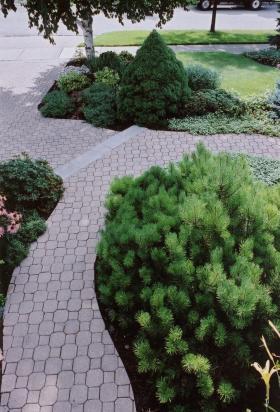December 8, 2014
Find a niche in curb appeal
BY SEAN JAMESThere’s lots of talk lately about curb appeal, and how much folks should invest in their homes. One of the main areas of discussion centres around selling a home, and what steps should be taken outdoors to speed up the sale and increase selling prices. There is an opportunity for contractors to work with elements that already exist in the landscape, to enhance value and appearance.

Before: overgrown evergreens and aging timbers detract from this home’s curb appeal.
Many homes have interlock pathways that perhaps could have been installed correctly the first time around. We’ll ignore that for now, BUT touching up sagged and sunken interlock, installing edging restraint and pressure washing out old sand and replacing it with new (removing the weeds in the process) is a great way to freshen up an entrance. If you can lay new stone, consider permeable pavers for a modern, eco-friendly look. Cost-effective design additions include the creation of a welcoming flare to where the path meets the driveway and perhaps even a soldier-course down the sides of the driveway. While checking hardscaping, watch for tripping hazards. The same applies to other hard surfaces on the property — look for general deterioration and how to fix it. It’s worth it. A quality patio, for instance, can add up to 12 per cent to a home’s value!
If a home is on the market in winter, keep in mind the vast majority of sales visits happen in the dark. LED low-voltage lighting makes the winter landscape look stunning, costs very little to run and uses only a fraction of the power of old-style lights. Picture a street full of dark houses, then, there shining in the night, is a warm, welcoming property. Which house do you think will be an easy sale? Night lighting is one of the best ways to improve the looks of the winter landscape.

After: Modernizing a pathway and keeping existing plants can be just what the real estate agent called for.
Budgets are usually very limited, but if there’s money for upgrading the plantings, remember flowers come and go, but texture will make or break your landscape. Consider adding plants which have bold or grassy texture. These types of textures are often lacking. Drought- and salt-tolerant sea kale, Crambe maritima, has great blue leaves and, when repeated a few times through a garden, can tie the whole thing together. A grouping of three native switchgrass clumps, Panicum virgatum, can provide great winter interest and colour changing from blue to red throughout the season.
There are many things which can be done to make a home more saleable. The ideas here represent just a taste. It’s not usually big money but it can be a reliable stream of medium-sized jobs that connects you with new clients and serves to get your name out in the community.
Sean James is owner of an Ontario-based environmentally-conscious landscape design/build/maintenance company, an eco-consultant and a popular speaker.